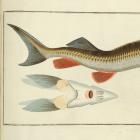Copyright Information
“‘Commanding, sovereign stream’: The Neva and the Viennese Danube in the History of Imperial Metropolitan Centers” was created by Gertrud Haidvogl, Alexei Kraikovski, and Julia Lajus (2019) under a Creative Commons Attribution 4.0 International license. This refers only to the text and does not include image rights. Please click on an image to view its individual rights status. Thumbnails of the following images appear on the exhibition landing page:

After the fortification walls were destroyed in 1858, the fish market was moved to the Donaukanal, where it existed until 1972. Franz Poledne, Franz-Josefskai – Am Schanzl, n.d.
After the fortification walls were destroyed in 1858, the fish market was moved to the Donaukanal, where it existed until 1972. Franz Poledne, Franz-Josefskai – Am Schanzl, n.d.
Courtesy of Wien Museum.

This work is licensed as a Public Domain Dedication.

Recreational fishing with fishing rods was still rare in the beginning of the nineteenth century. Adolf Kunike, Dorf Nussdorf, 1826.
Recreational fishing with fishing rods was still rare in the beginning of the nineteenth century. Adolf Kunike, Dorf Nussdorf, 1826.
Courtesy of Wien Museum.

This work is licensed as a Public Domain Dedication.

The sterlet belongs to the family of sturgeons. In contrast to the diadromous Beluga sturgeon, it is a pure freshwater fish and still inhabits the Austrian Danube. Illustration by George Bodenehr and Krüger, late eighteenth century.
The sterlet belongs to the family of sturgeons. In contrast to the diadromous Beluga sturgeon, it is a pure freshwater fish and still inhabits the Austrian Danube. Illustration by George Bodenehr and Krüger, late eighteenth century.
© Naturhistorisches Museum, Wien.
Originally published in Bloch, Marcus Elieser. Allgemeine Naturgeschichte der Fische. Berlin: Morino, 1782–95. Plate 89.
This work is used by permission of the copyright holder.

The wooden bridges gradually disappeared in the nineteenth century and do not exist in the city anymore. Granite embankments appeared in the second half of the eighteenth century. Andrey Yefimovich Martynov, View of the Moika River by the Imperial Stables, 1809. Watercolour and Indian ink, 60 x 86 cm.
The wooden bridges gradually disappeared in the nineteenth century and do not exist in the city anymore. Granite embankments appeared in the second half of the eighteenth century. Andrey Yefimovich Martynov, View of the Moika River by the Imperial Stables, 1809. Watercolour and Indian ink, 60 x 86 cm.
© The State Hermitage Museum
This work is used by permission of the copyright holder.

A policeman warns a drowning person that he shouldn’t drink the water—as if this were a greater danger than drowning. Caricature from the journal Satirikon, 1908. Illustration by Re Mi.
A policeman warns a drowning person that he shouldn’t drink the water—as if this were a greater danger than drowning. Caricature from the journal Satirikon, 1908. Illustration by Re Mi.
Courtesy of the State Museum of the History of St Petersburg
 This work is licensed under a Creative Commons Public Domain Mark 1.0 License.
This work is licensed under a Creative Commons Public Domain Mark 1.0 License.
Invalid Scald ID.












